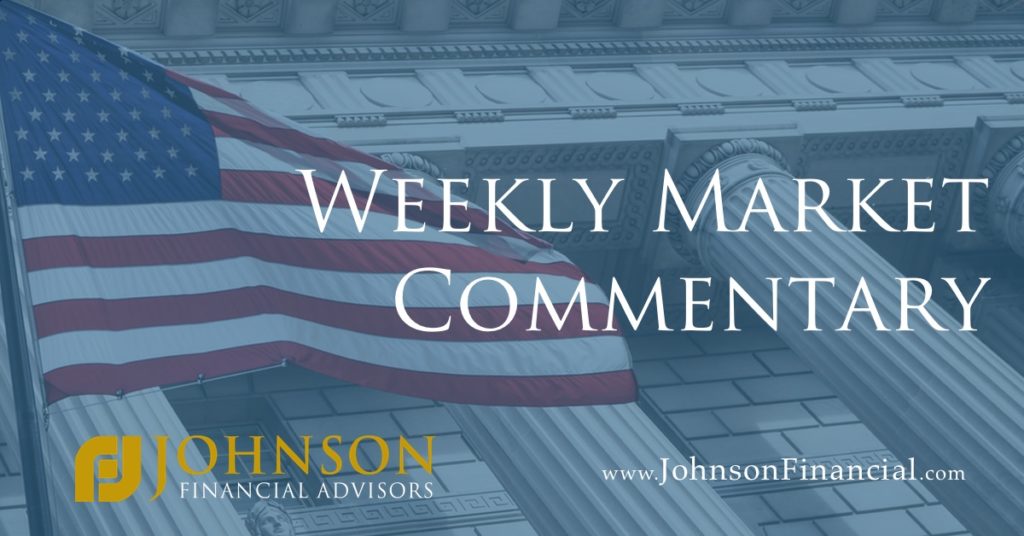
Weekly Market Commentary – 01/15/2018
The Markets
The three major indexes posted record gains Friday. Following the Monday holiday, the three benchmarks enjoyed their strongest first four trading days of a year for more than a decade. For the week, the Dow rose 2.37 percent to close at 25,295.87. The S&P gained 2.63 percent to finish at 2,743.15, and the NASDAQ climbed 3.38 percent to end the week at 7,136.56.
- The Consumer Price index rose 0.1% in December and is up 2.1% from a year ago
- Retail sales increased 0.4% in December and are up 6.3% over the past year
- This was the strongest year of sales since 2012
- The Producer Price index declined -0.1% in December and is up 2.6% versus a year ago
- The probability of a rate hike for the March 2018 Fed Meeting is currently around 88%
- It is early but with only 30 of 500 companies reporting earnings so far, there is earnings growth of 12.83%
- This number should change as more companies report their financial results
| Returns Through 1/12/18 | 1 Week | YTD | 1 Year | 3 Year | 5 Year |
| Dow Jones Industrials (TR) | 2.02 | 4.44 | 32.85 | 16.40 | 16.69 |
| NASDAQ Composite (PR) | 1.74 | 5.18 | 30.89 | 15.89 | 18.36 |
| S&P 500 (TR) | 1.61 | 4.28 | 25.19 | 13.52 | 16.01 |
| Barclays US Agg Bond (TR) | -0.18 | -0.50 | 2.52 | 1.69 | 2.05 |
| MSCI EAFE (TR) | 1.20 | 3.68 | 26.75 | 9.94 | 7.99 |
Oil — With oil at $44 a barrel on Sept. 5, 2016, RBC’s global head of commodity strategy Helima Croft predicted the price of oil would rise to $60 in 2017. Oil closed at $60.12 a barrel on Dec. 29, 2017, its high for the year (source: CNBC, BTN Research).
Going Away — In July 2017, Dr. James Canton, CEO of the Institute of Global Futures in San Francisco, predicted these six things will no longer exist within a decade: keys, parking meters, cash, brick-and-mortar banks, televisions and telephones (source: NBC News MACH, BTN Research).
Not Crazy at All — With the Dow at 12,500 in June 2012, Seth Masters, the chief investment officer at Bernstein Global Wealth Management, predicted the 30-stock index would cross 20,000 by 2020. The Dow first closed above 20,000 on Jan. 27, 2017, and closed at 25,296 on Friday, Nov. 5, 2017. (Source: Wall Street Journal, BTN).
WEEKLY FOCUS – Smart Things to Do With a Year-End Bonus
Last month, CNBC reported 63 percent of firms planned to give employees bonuses for 2017. If you work for one of those companies, it is wise to come up with a thoughtful plan for the extra cash. If you need more time to consider your options, deposit the money in a savings account. It will be harder to chip away at it if it’s not connected to your debit card. Here are a few other suggestions.
Increase your bonus’ value. Contributing the maximum allowed to a pretax employer retirement plan can make your bonus go farther than using it as after-tax dollars, especially if your employer matches the contributions. If your income falls within IRS guidelines, you may be able to make pretax contributions to your 401(k) AND a traditional IRA or add post-tax contributions to a Roth IRA – that will grow tax-free. Depending on your health insurance policy and your employer’s offerings, you may also be able to contribute pretax dollars to a Flexible Spending Account or a Health Savings Account.
Build your emergency fund. Everyone should have liquid savings available to cover six months’ worth of living expenses when the unexpected occurs. If you keep your fund in a savings account, be sure to shop around for the best rates.
Put your money to work. Sometimes it is more efficient to rebalance your portfolio by introducing new money than by selling stocks off. You can also reduce the amount of interest you’ll pay on your home loan by making an extra payment to the interest.
Invest in yourself. Many of the most successful people continually pursue knowledge and increase their skills. You might take a coding course, learn a language, hire a health coach, pay for a professional certification or enroll in a professional speaking program.
Enjoy an experience. Recent research indicates great memories often provide more satisfaction than purchases. And shopping for a summer vacation now while everyone else is recovering from Christmas can be a good way to find deals on flights and hotel rooms.
Enrich others. If you have a child or grandchild, you can contribute up to $15,000 to their 529 plan (combined with all other gifts to the same beneficiary in 2018). Or you can help others in need or further your favorite cause. If you need more time to choose a charitable organization, you might consider opening a donor-advised fund now and make your decision later.
We’re here to help you reap the rewards of your success and build a brighter tomorrow. Call our office to schedule time to discuss what you want to accomplish in 2018 and beyond.
